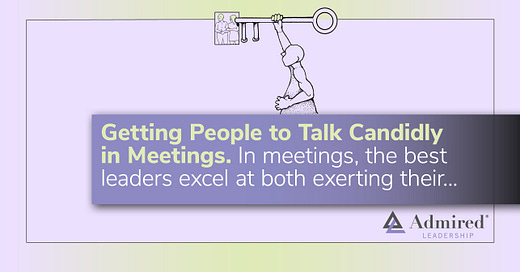In meetings, the best leaders excel at both exerting their viewpoints and relinquishing the floor to others.
Leaders who share power and keep their airtime to a minimum earn the respect and appreciation of the team. The idea that talking too much can crowd out the contributions of others is instinctive for effective meeting leaders.
But despite the best efforts of leaders who listen more and talk less, some team members remain reticent in offering their candid views. On some teams, one or two team members don’t speak at all, preferring to soak it all in and watch the action from the sidelines. This pattern is reinforced by prior meetings where silence was accepted and team members who played it safe by dulling their viewpoints were never challenged.
Leaders need to break this pattern without resorting to draconian measures like calling on people and putting them on the spot. Making others uncomfortable usually results in less interaction, not more. So what can a leader do to encourage everyone to speak their mind and to participate fully in the discussion?
Anytime a leader wants to get everyone talking and offering their candid views, the best choice is to break the discussion into smaller conversations.
When most leaders think of “breakouts,” they think of training or conference programs where team members gather in a separate room to discuss an issue and then return to report their conclusions to the larger team.
Breakouts work because they reduce status between team members and diminish the fishbowl effect of speaking to the larger group. By engaging in a less threatening, smaller conversation before returning to the larger discussion, even reticent team members become more open and willing to express their true views.
The same idea can work in any meeting without the need for separate rooms or space. By asking team members to work in threes or pairs to first discuss an issue or problem before the group grapples with the topic, team members open up and register what they really think.
This can be accomplished simply by asking others to turn their chairs or to huddle. Once the breakout groups or dyads have completed their conversation, the request to bring their views to the larger discussion breaks the logjam of reticence and gets everyone talking.
Don’t save breakouts for training and large group programs. Use them in everyday meetings to get everyone involved and talking. Effective meetings require everyone to make a contribution and to speak their mind regarding critical issues. Breakouts get that done.





So I totally agree that breakouts can be super effective, AND I think this piece would have been more powerful if you had noted how you can make breakouts happen in either hybrid (some people in person, some people online) or all virtual meetings. Sometimes in virtual meetings, it's even easier for people to remain quiet or a few to dominate, making breakouts invaluable.
Zoom will let a meeting host facilitate these quick mini-breakouts easy enough too. It is worth experimenting with the functionality if you've not seen it in action before.